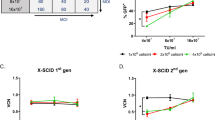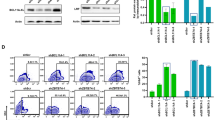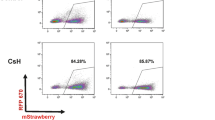Abstract
The efficient control of gene expression in vivo from lentiviral vectors remains technically challenging. To analyze inducible gene expression in a human setting, we generated ‘human immune system’ (HIS) mice by transplanting newborn BALB/c Rag2−/−IL-2Rγc−/− immunodeficient mice with human hematopoietic stem cells transduced with a doxycycline-inducible lentiviral vector. We compared several methods of doxycycline delivery to mice, and could accurately measure doxycycline in vivo using a new sensitive detection assay. Two different lentiviral vector designs with constitutive (TRECMV-V14) or autoregulatory (TREAuto-V14) expression of an optimized reverse tetracycline transactivator were used to transduce human hematopoietic stem cells. After transplantation into immunodeficient mice, we analyzed the expression of the green fluorescent protein (GFP) reporter gene in the human hematopoiesis-derived cells that develop and accumulate in the generated HIS mice. We show efficient inducible GFP expression in adult HIS mice containing TREAuto-V14-transduced human cells, whereas GFP expression is poor with the TRECMV-V14 vector. Multiple cycles of doxycycline exposure in the TREAuto-V14 group result in repeated cycles of GFP expression with no loss of intensity. These findings are of major interest for gene therapy and basic research settings that require inducible gene expression.
This is a preview of subscription content, access via your institution
Access options
Subscribe to this journal
Receive 12 print issues and online access
$259.00 per year
only $21.58 per issue
Buy this article
- Purchase on Springer Link
- Instant access to full article PDF
Prices may be subject to local taxes which are calculated during checkout





Similar content being viewed by others
References
Corbel SY, Rossi FM . Latest developments and in vivo use of the Tet system: ex vivo and in vivo delivery of tetracycline-regulated genes. Curr Opin Biotechnol 2002; 13: 448–452.
Toniatti C, Bujard H, Cortese R, Ciliberto G . Gene therapy progress and prospects: transcription regulatory systems. Gene Therapy 2004; 11: 649–657.
Hillen W, Berens C . Mechanisms underlying expression of Tn10 encoded tetracycline resistance. Annu Rev Microbiol 1994; 48: 345–369.
Hillen W, Gatz C, Altschmied L, Schollmeier K, Meier I . Control of expression of the Tn10-encoded tetracycline resistance genes. Equilibrium and kinetic investigation of the regulatory reactions. J Mol Biol 1983; 169: 707–721.
Gossen M, Freundlieb S, Bender G, Müller G, Hillen W, Bujard H . Transcriptional activation by tetracyclines in mammalian cells. Science 1995; 268: 1766–1769.
Gossen M, Bujard H . Tight control of gene expression in mammalian cells by tetracycline-responsive promoters. Proc Natl Acad Sci USA 1992; 89: 5547–5551.
Mohammadi S, Alvarez-Vallina L, Ashworth LJ, Hawkins RE . Delay in resumption of the activity of tetracycline-regulatable promoter following removal of tetracycline analogues. Gene Therapy 1997; 4: 993–997.
Urlinger S, Baron U, Thellmann M, Hasan MT, Bujard H, Hillen W . Exploring the sequence space for tetracycline dependent transcriptional activators: novel mutations yield expanded range and sensitivity. Proc Natl Acad Sci USA 2000; 97: 7963–7968.
Das AT, Zhou X, Vink M, Klaver B, Verhoef K, Marzio G et al. Viral evolution as a tool to improve the tetracycline-regulated gene expression system. J Biol Chem 2004; 279: 18776–18782.
Zhou X, Vink M, Klaver B, Berkhout B, Das AT . Optimization of the Tet-On system for regulated gene expression through viral evolution. Gene Therapy 2006; 13: 1382–1390.
Markusic D, Oude-Elferink R, Das AT, Berkhout B, Seppen J . Comparison of single regulated lentiviral vectors with rtTA expression driven by an autoregulatory loop or a constitutive promoter. Nucleic Acids Res 2005; 33: e63.
Barde I, Zanta-Boussif MA, Paisant S, Leboeuf M, Rameau P, Delenda C et al. Efficient control of gene expression in the hematopoietic system using a single Tet-on inducible lentiviral vector. Mol Ther 2006; 13: 382–390.
Macchiarini F, Manz MG, Palucka AK, Shultz LD . Humanized mice: are we there yet? J Exp Med 2005; 202: 1307–1311.
Legrand N, Weijer K, Spits H . Experimental models to study development and function of the human immune system in vivo. J Immunol 2006; 176: 2053–2058.
Manz MG . Human-hemato-lymphoid-system mice: opportunities and challenges. Immunity 2007; 26: 537–541.
Shultz LD, Ishikawa F, Greiner DL . Humanized mice in translational biomedical research. Nat Rev Immunol 2007; 7: 118–130.
Gimeno R, Weijer K, Voordouw A, Uittenbogaart CH, Legrand N, Alves NL et al. Monitoring the effect of gene silencing by RNA interference in human CD34+ cells injected into newborn RAG2−/− gammac−/− mice: functional inactivation of p53 in developing T cells. Blood 2004; 104: 3886–3893.
Traggiai E, Chicha L, Mazzucchelli L, Bronz L, Piffaretti JC, Lanzavecchia A et al. Development of a human adaptive immune system in cord blood cell-transplanted mice. Science 2004; 304: 104–107.
Vigna E, Cavalieri S, Ailles L, Geuna M, Loew R, Bujard H et al. Robust and efficient regulation of transgene expression in vivo by improved tetracycline-dependent lentiviral vectors. Mol Ther 2002; 5: 252–261.
Kleibeuker W, Zhou X, Centlivre M, Legrand N, Page M, Almond N et al. A sensitive cell-based assay to measure the doxycycline concentration in biological samples. Hum Gene Ther 2009, (e-pub ahead of print; doi:10.1089/hum.2008.182).
Dull T, Zufferey R, Kelly M, Mandel RJ, Nguyen M, Trono D et al. A third-generation lentivirus vector with a conditional packaging system. J Virol 1998; 72: 8463–8471.
Zufferey R, Dull T, Mandel RJ, Bukovsky A, Quiroz D, Naldini L et al. Self-inactivating lentivirus vector for safe and efficient in vivo gene delivery. J Virol 1998; 72: 9873–9880.
Seppen J, Rijnberg M, Cooreman MP, Oude Elferink RP . Lentiviral vectors for efficient transduction of isolated primary quiescent hepatocytes. J Hepatol 2002; 36: 459–465.
Ter Brake O, Berkhout B . Lentiviral vectors that carry anti-HIV shRNAs: problems and solutions. J Gene Med 2007; 9: 743–750.
Back NKT, Nijhuis M, Keulen W, Boucher CAB, Oude Essink BB, van Kuilenburg ABP et al. Reduced replication of 3TC-resistant HIV-1 variants in primary cells due to a processivity defect of the reverse transcriptase enzyme. EMBO J 1996; 15: 4040–4049.
Weijer K, Uittenbogaart CH, Voordouw A, Couwenberg F, Seppen J, Blom B et al. Intrathymic and extrathymic development of human plasmacytoid dendritic cell precursors in vivo. Blood 2002; 99: 2752–2759.
Legrand N, Weijer K, Spits H . Experimental model for the study of the human immune system: production and monitoring of “human immune system” Rag2−/−gamma c−/− mice. Methods Mol Biol 2008; 415: 65–82.
Ter Brake O, Legrand N, von Eije KJ, Centlivre M, Spits H, Weijer K et al. Evaluation of safety and efficacy of RNAi against HIV-1 in the human immune system Rag-2(−/−) gamma-c(−/−) mouse model. Gene Therapy 2009; 16: 148–153.
Huntington ND, Legrand N, Alves NL, Jaron B, Weijer K, Plet A et al. IL-15 trans-presentation promotes human NK cell development and differentiation in vivo. J Exp Med 2009; 206: 25–34.
Yssel H, De Vries JE, Koken M, Van Blitterswijk W, Spits H . Serum-free medium for generation and propagation of functional human cytotoxic and helper T cell clones. J Immunol Methods 1984; 72: 219–227.
Legrand N, Cupedo T, van Lent AU, Ebeli MJ, Weijer K, Hanke T et al. Transient accumulation of human mature thymocytes and regulatory T cells with CD28 superagonist in “human immune system” Rag2(−/−)gammac(−/−) mice. Blood 2006; 108: 238–245.
Barza M, Brown RB, Shanks C, Gamble C, Weinstein L . Relation between lipophilicity and pharmacological behavior of minocycline, doxycycline, tetracycline, and oxytetracycline in dogs. Antimicrob Agents Chemother 1975; 8: 713–720.
Li X, Zhao X, Fang Y, Jiang X, Duong T, Fan C et al. Generation of destabilized green fluorescent protein as a transcription reporter. J Biol Chem 1998; 273: 34970–34975.
Hojman P, Eriksen J, Gehl J . Tet-On induction with doxycycline after gene transfer in mice: sweetening of drinking water is not a good idea. Anim Biotechnol 2007; 18: 183–188.
Cawthorne C, Swindell R, Stratford IJ, Dive C, Welman A . Comparison of doxycycline delivery methods for Tet-inducible gene expression in a subcutaneous xenograft model. J Biomol Tech 2007; 18: 120–123.
Honnorat-Benabbou VC, Lebugle AA, Sallek B, Duffaut-Lagarrigue D . Stability study of tetracyclines with respect to their use in slow release systems. J Mater Sci Mater Med 2001; 12: 107–110.
Fitzsimons HL, Bland RJ, During MJ . Promoters and regulatory elements that improve adeno-associated virus transgene expression in the brain. Methods 2002; 28: 227–236.
Prosch S, Stein J, Staak K, Liebenthal C, Volk HD, Kruger DH . Inactivation of the very strong HCMV immediate early promoter by DNA CpG methylation in vitro. Biol Chem Hoppe Seyler 1996; 377: 195–201.
Mehta AK, Majumdar SS, Alam P, Gulati NBV . Epigenetic regulation of cytomegalovirus major immediate-early promoter activity in transgenic mice. Gene 2009; 428: 20–24.
Hogquist KA, Baldwin TA, Jameson SC . Central tolerance: learning self-control in the thymus. Nat Rev Immunol 2005; 5: 772–782.
Stieger K, Mendes-Madeira A, Meur GL, Weber M, Deschamps JY, Nivard D et al. Oral administration of doxycycline allows tight control of transgene expression: a key step towards gene therapy of retinal diseases. Gene Therapy 2007; 14: 1668–1673.
Vigna E, Amendola M, Benedicenti F, Simmons AD, Follenzi A, Naldini L . Efficient Tet-dependent expression of human factor IX in vivo by a new self-regulating lentiviral vector. Mol Ther 2005; 11: 763–775.
Herold MJ, van den BJ, Seibler J, Reichardt HM . Inducible and reversible gene silencing by stable integration of an shRNA-encoding lentivirus in transgenic rats. Proc Natl Acad Sci USA 2008; 105: 18507–18512.
Marzio G, Verhoef K, Vink M, Berkhout B . In vitro evolution of a highly replicating, doxycycline-dependent HIV for applications in vaccine studies. Proc Natl Acad Sci USA 2001; 98: 6342–6347.
Verhoef K, Marzio G, Hillen W, Bujard H, Berkhout B . Strict control of human immunodeficiency virus type 1 replication by a genetic switch: Tet for Tat. J Virol 2001; 75: 979–987.
Das AT, Verhoef K, Berkhout B . A conditionally replicating virus as a novel approach toward an HIV vaccine. Methods Enzymol 2004; 388: 359–379.
Acknowledgements
This research was sponsored by the Dutch AIDS Foundation (AIDS Fonds, Grant 2005022), the International AIDS Vaccine Initiative (IAVI), the Technology Foundation STW (the applied science division of NWO and the technology program of the Ministry of Economic Affairs, Utrecht, The Netherlands) and the NIH/NIAD (No. R21-AI073136). M Centlivre is supported by Marie Curie Intra-European fellowship (MEIF-CT-2007-039689). N Legrand is supported by the Bill and Melinda Gates Foundation (Grand Challenges in Global Health program—GC4 ‘Human Vaccine Consortium’). We thank the staff of the ABSL-3 unit of the Animal Research Institute Amsterdam (ARIA) of the AMC-UvA for excellent care of the animals. We also thank Joost Dalhuizen for technical support, Berend Hooibrink for expertise in cell sorting and maintenance of the flow cytometry facility and Marc Douaisi and Christel Uittenbogaart for discussions. Finally, we are grateful to the Bloemenhove Clinic (Heemstede, The Netherlands) for providing fetal tissues. MC designed and performed the research, collected, analyzed and interpreted the data, and wrote the paper. XZ contributed new reagents, and analyzed and interpreted the data. SP and KW performed the research. WK and ATD contributed new reagents. BBl, JS and BBe analyzed and interpreted the data. NL designed and performed the research; collected, analyzed and interpreted the data, and wrote the paper. All authors read and edited the paper.
Author information
Authors and Affiliations
Corresponding author
Rights and permissions
About this article
Cite this article
Centlivre, M., Zhou, X., Pouw, S. et al. Autoregulatory lentiviral vectors allow multiple cycles of doxycycline-inducible gene expression in human hematopoietic cells in vivo. Gene Ther 17, 14–25 (2010). https://doi.org/10.1038/gt.2009.109
Received:
Revised:
Accepted:
Published:
Issue Date:
DOI: https://doi.org/10.1038/gt.2009.109
Keywords
This article is cited by
-
Doxycycline-loaded nanotube-modified adhesives inhibit MMP in a dose-dependent fashion
Clinical Oral Investigations (2018)
-
Graded or threshold response of the tet-controlled gene expression: all depends on the concentration of the transactivator
BMC Biotechnology (2013)
-
Preclinical In Vivo Evaluation of the Safety of a Multi-shRNA-based Gene Therapy Against HIV-1
Molecular Therapy - Nucleic Acids (2013)
-
Adeno-associated virus serotype 2 mediated transduction and coexpression of the human apoAI and SR-BI gene in HepG2 cells
Molecular Biology Reports (2012)



